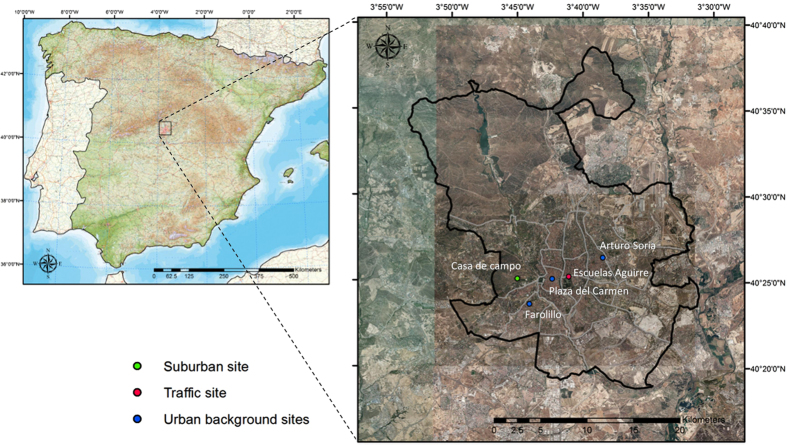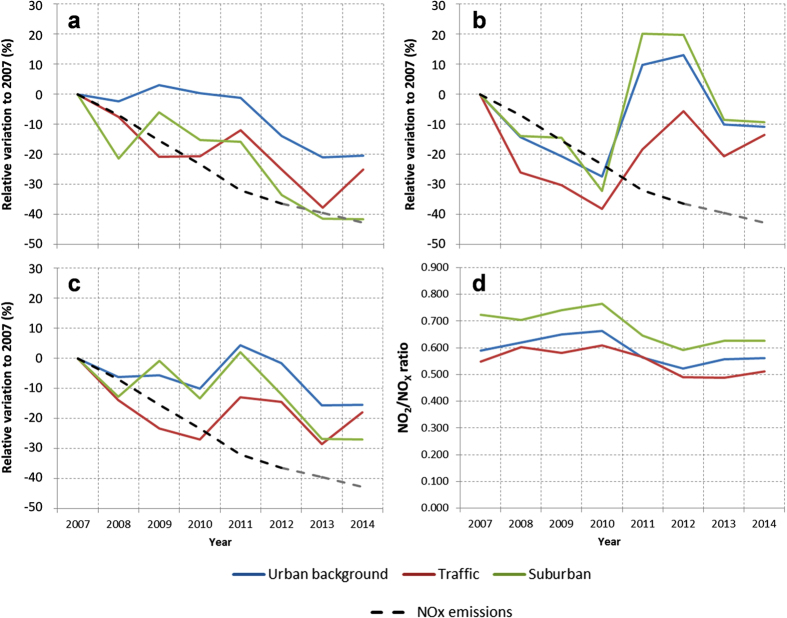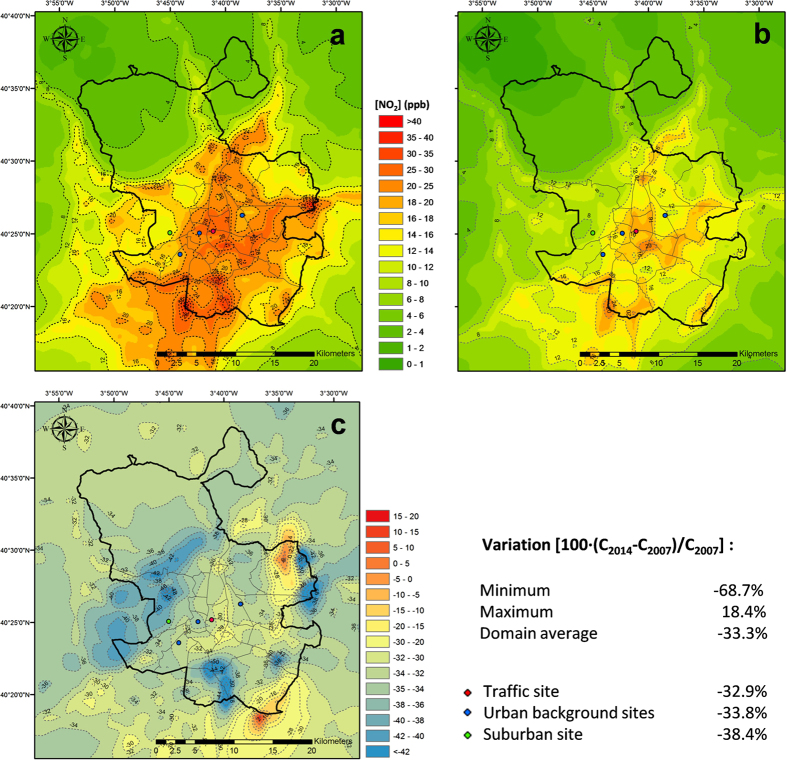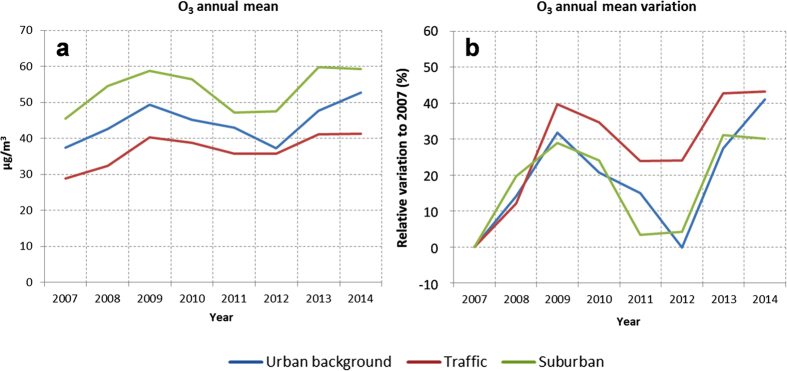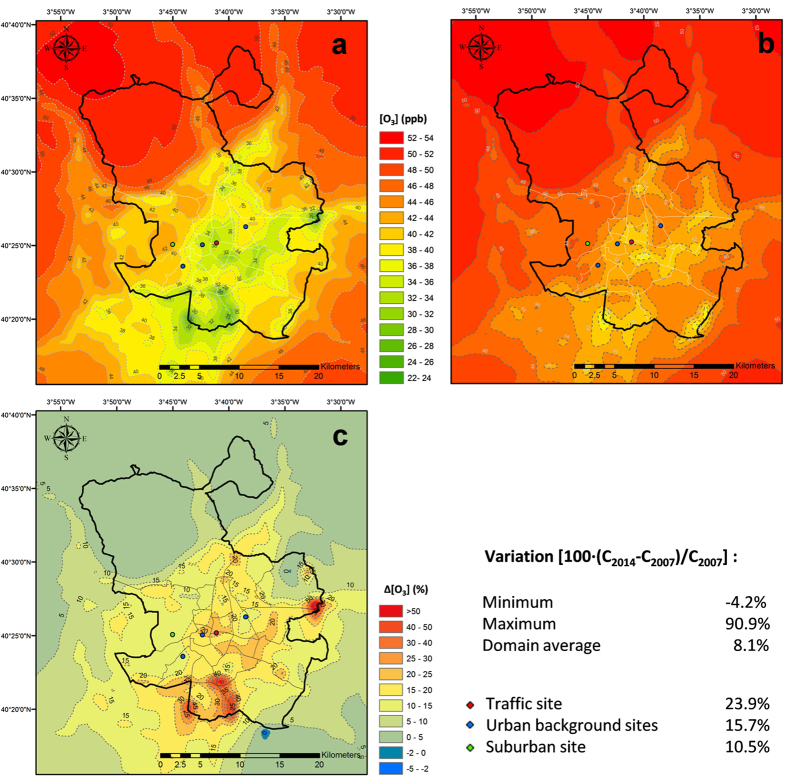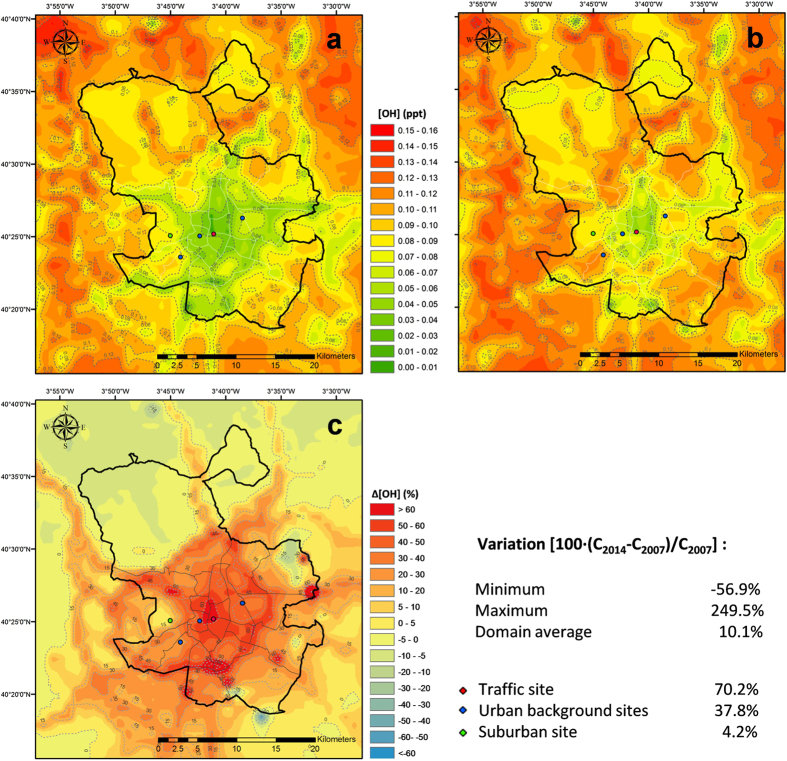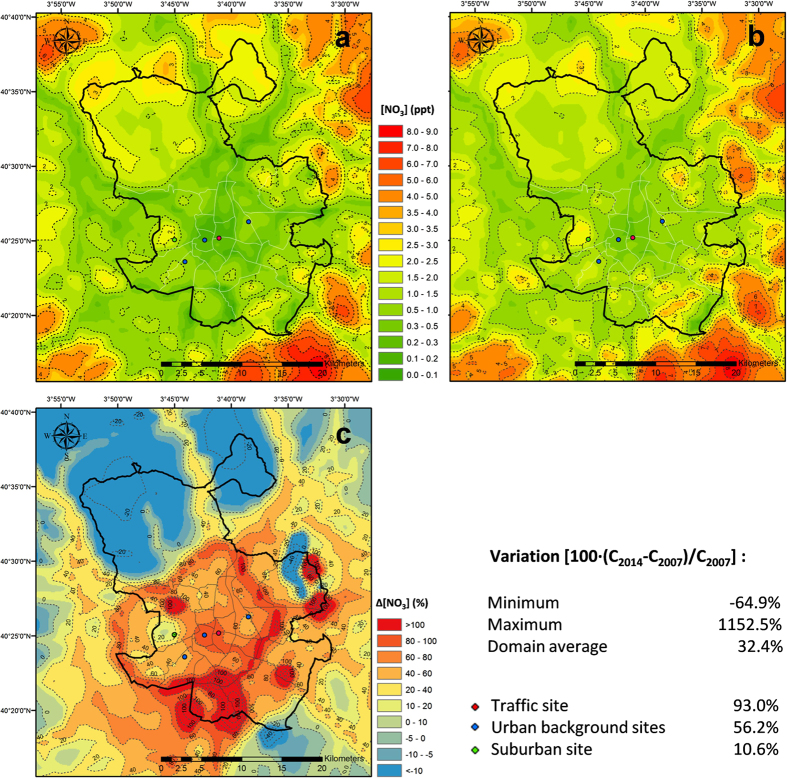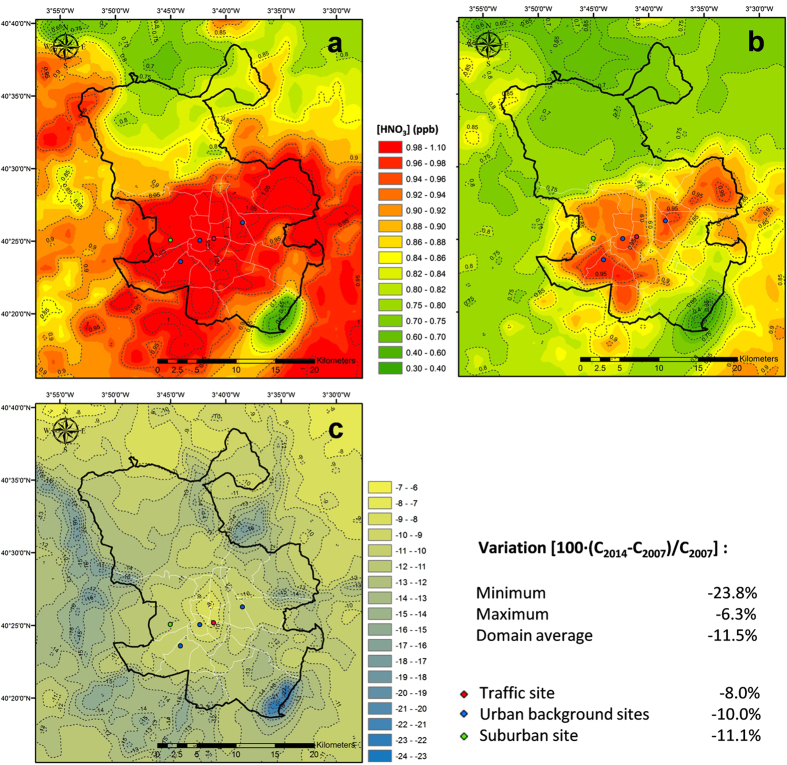Abstract
Atmospheric oxidants such as ozone (O3), hydroxyl and nitrate radicals (OH and NO3) determine the ability of the urban atmosphere to process organic and inorganic pollutants, which have an impact on air quality, environmental health and climate. Madrid city has experienced an increase of 30–40% in ambient air O3 levels, along with a decrease of 20–40% in NO2, from 2007 to 2014. Using air pollution observations and a high-resolution air quality model, we find a large concentration increase of up to 70% and 90% in OH and NO3, respectively, in downtown Madrid (domain-wide average increase of 10% and 32% for OH and NO3, respectively). The results also show an 11% reduction in the nitric acid concentrations, leading to a remarkable denoxification of this urban atmosphere with implications for lower PM2.5 levels and nitrogen input into ecosystems. This study suggests that projected worldwide NOx emission reductions, following air quality standards, will lead to important changes in the oxidizing capacity of the atmosphere in and around large cities.
Nitrogen oxides (NOx = NO + NO2) ambient concentrations can have important implications for human health1 and have become a relevant target of environmental policies for many cities worldwide2,3,4. NOx emissions are directly related to combustion processes, including mobile sources that are particularly relevant for urban environments, where exceedances of NO2 human protection thresholds occur frequently5. Many cities in Europe are having difficulties to meet the NO2 standards established by the European Air Quality Directive6. The European Environment Agency (EEA)5 reported that 8% of the EU population are exposed to NO2 levels that exceed European and World Health Organization (WHO) air quality targets. Recent observations have reported reductions of NO2 concentrations in urban areas following the application of environmental policies and the effects of recent economic recessions2,4,7. In the EU, it was reported that the 2003–2012 decrease was −18% (−0.4 and −0.7 μg NO2/m3/year for urban and traffic sites (EEA 2014), which was markedly lower than that of the EU NOx emission inventory for the same period (−30%), due to the preferential decrease of NO versus NO2. Combined ground- and satellite-based measurements carried out from 1996 to 2012 have shown a dramatic decrease in tropospheric NO2 over the largest and most industrialized cities of Spain, including Madrid8. Remarkably, this decrease was more abrupt from 2008 to 2012 attributed primarily to emissions cut downs due to the economic recession8. Nevertheless, the efficient role of local emission abatement measures in the recently observed reduction of NO2 ambient levels in Madrid has also been suggested9.
NOx levels influence O310 and other photochemical pollutants8,11, for example as precursors of the NO3 radical, the main oxidant of the nocturnal atmosphere12,13,14,15. Hence, changes in NOx emissions may have important impacts on the chemistry of an urban atmosphere and its oxidizing capacity, i.e. the efficiency of the atmosphere to oxidize and ultimately remove the large variety of organic and inorganic species that are emitted into it from both anthropogenic and natural sources. Over recent years, observations show a general increasing trend of O3 concentrations in European urban areas5. This has been mostly attributed to: i) the occurrence of these trends in volatile organic compounds (VOCs)-sensitive areas (where NOx reduction might increase O3 levels) (EEA, 2014); or ii) the decrease of the NO/NO2 emission and ambient air ratios, what in turn reduces the O3 consumption (titration effect) by NO16.
Besides being a greenhouse gas and have harmful implications for vegetation and human health17,18, tropospheric O3 is also the main source of OH radicals, the most influential tropospheric oxidant in daytime atmospheric chemistry. The OH radical initiates many oxidation reactions in the troposphere, leading to the formation of new secondary photochemical smog pollutants, including more O3. The oxidation of organic compounds by OH can also enhance the formation of secondary organic aerosols (SOA), which has implications for environmental health and climate19,20.
During the night, the concentration of OH is drastically reduced and the oxidizing capacity of the atmosphere is then controlled by NO3 (together with ozone, which is also an important tropospheric oxidant). The amount of VOCs oxidised by NO3 at night is comparable to that due to OH during the day21. The NO3 radical is also a very important chemical sink for isoprene and other biogenic VOCs, whose atmospheric oxidation results in the formation of SOA precursors5.
Here we combine observations and a state-of-the-art mesoscale air quality modelling system (AQM) to assess the impact of the observed rapid change in NOx emissions and O3 levels, recorded during 2007–2014, on the chemistry and oxidizing capacity of the urban atmosphere of Madrid. We assume that 2007 is representative (as baseline) for recent changes in emissions and air quality, because it corresponds to the last year before the economic recession, and the implementation of Madrid’s air quality plan intended to meet NO2 ambient concentration standards. Also 2007 does not present exceptional meteorological features.
Results
NOx concentration trends
Five representative monitoring stations from the Air Quality Network (AQN) of Madrid were selected to carry out this study (Fig. 1). The selected stations are adequate to investigate the air quality evolution in the Madrid metropolitan area since they are typical of locations directly influenced by intense traffic emissions (Escuelas Aguirre), urban background (Plaza del Carmen, Arturo Soria and Farolillo) and suburban (Casa de Campo) environments. This allows assessing the influence of different emission sources on pollutant concentrations under a variety of temporal and spatial atmospheric phenomena. Note that unlike the rest of monitoring stations of the Madrid AQN, they have not been relocated and have a complete record of hourly NOx and O3 data for the period of interest (>98% hourly data coverage), thus providing a consistent view of air quality evolution in the city.
Figure 1.
Localization within the Iberian Peninsula and general view of the modelling domain including the location of the air quality monitoring stations selected for this study. The black line represents the limits of the Madrid municipality. Figure created by the authors using ArcGis 10 (http://www.esri.com/software/arcgis/arcgis-for-desktop) and maps from ©Instituto Geográfico Nacional of Spain (http://centrodedescargas.cnig.es/CentroDescargas/).
A decrease of 20–40% in NO2 levels was registered by the different stations during 2007–2014 (3–6%/year Fig. 2a), with a mean change rate of −1.6 and −2.7 μgNO2/m3/year for urban background and the traffic sites, respectively. These decreasing rates are much more pronounced than the EU averaged rates for the same period and type of urban sites reported by the European Environmental Agency22: −0.4 and −0.7 μgNO2/m3/year, respectively (2%/year). Other studies8,23 reported a reduction of 37% in the 1996–2012 period (2.3%/year). In the case of NO, the measurements show a decrease around 10–15% in 2014 respect to the measured levels in 2007 (Fig. 2b). A decrease in the NO2/NOX ratio is observed in Madrid during the period of analysis although positive slopes occur on individual years. This effect cannot be explained only by NOx emission trends (represented by dashed lines in Fig. 2), since they follow a clear monotonic decreasing tend over the period of interest. Further inspection of emission datasets reveal that no substantial changes on the speciation of NOX emission exist during the period analysed. Hence, the NO increases observed for 2011 and 2012 may be influenced by variations in local meteorological conditions that led to particularly high NO levels in winter (Fig. S1). Analysis of the monthly temperature during the cold months (November to February) of 2011 and 2012 reveals similar values to those of the rest of the data series, between 5 and 10 °C. Monthly mixing layer height does not show significant differences, with values between ~650 m in December and ~1000 m in February, similar to the other years. However, the wind speed data shows stagnant periods of calm winds during the winters of 2011 and 2012 (Fig. S2). Additionally, two-temperature measurements of deep surface inversions confirm these strong stability conditions (Fig. S2), which are not revealed by estimations of mixing layer height provided by models. These conditions favour primary NO accumulation while low temperature and radiation limit its oxidation to NO2, consistent with the NO2/NOX decrease observed in Fig. 2d. Therefore, meteorological factors such as major atmospheric stagnation and resulting less atmospheric dispersion in the lower layers could influence the anomalous NO2/NOX behaviour recorded during these two years. Although these phenomena may deserve a more specific analysis, this study focuses on the net internal variation of air quality over the city, which minimizes the influence of local factors and provides more robust and policy-relevant information.
Figure 2.
Ambient air concentration change (relative to levels of 2007) of (a) NO2; (b) NO and (c) NOx. Dashed line corresponds to the variation of NOx emissions in Madrid during the same period. (d) NO2/NOx ratio measured from 2007–2014.
NOx levels are 15–30% lower in 2014 than in 2007 (Fig. 2). Total NOx emissions according to the Madrid’s local emission inventory24 have dropped from 20839 t yr−1 in 2007 to 13264 t yr−1 in 2012, last year available. According to emission projections, two years later the emissions have further dropped to 11913 t yr−1 in 20149. This represents a 42% decrease in NOx emissions between 2007 and 2014. These trends are strongly related to emission reductions in the road traffic sector, that globally contributes to 59% of ambient NO2 concentration levels in the modelling domain used in this study (up to 90% in the city centre). Anthropogenic VOCs emissions (93% of total VOCs in 2007) are reduced by 7% in that period in the modelling domain. Further details on emissions scenario computation and source apportionment can be found elsewhere9. The observed nonlinearities between NOx emissions and NO2 trends in Madrid have also been the subject of evaluation in previous studies8,25. Dispersion processes and NOx speciation, as well as other local factors such as the influence of background levels, affect differently to the diverse emission sources throughout the city so that the effect of emission reductions is not proportional to the observed air quality levels.
The CMAQ (Community Multiscale Air Quality) mesoscale chemical-transport model26,27,28,29 is used here to simulate pollutant trends and its associated atmospheric impacts not only at the location of air quality monitoring stations but over a modelling domain that covers the entire metropolitan area. Analysis of the CMAQ results (Fig. 3) shows a NO2 decrease of 32–38% across the different typology stations, and 33% over the entire metropolitan area, in good agreement with the decrease (20–40%) measured by the AQN in Madrid (Fig. 1).
Figure 3.
Modelled NO2 annual mean concentration, (a) 2007; (b) 2014. (c) Variation of NO2 annual mean concentration in 2014 with respect to 2007 and resulting statistics. Positive values indicate concentration increase. Figure created by the authors using ArcGis 10 (http://www.esri.com/software/arcgis/arcgis-for-desktop).
O3 concentration trends
Figure 4 shows the remarkable increase in annual averaged O3 levels during this period. Increases of more than 10 μg m−3 as integrated annual levels are measured in 2014 by comparison with 2007 throughout all monitoring stations (Fig. 4a). The slope of the corresponding trends during 2007–2014 demonstrates a general positive progression of O3 concentrations over Madrid. The percentage of O3 concentration change in 2014 with respect to the 2007 levels ranges from 30% to 43% in suburban and traffic stations, respectively, (Fig. 4b). The evolution of the daily average concentration profile of O3 in the period 2007–2014 shows an increase throughout the day for all seasons, as represented in Fig. 5, where evolution of the daily average levels of ozone from 2007 to 2014 (data relative to 2007) is plotted. The relative 24 h-integrated increment is particularly noticeable for winter (66% as an average). Maximum O3 differences of up to 80% occur around the morning traffic rush hours (up to 30 μg m−3 in spring). This is due to the strong reduction in NO emissions from road traffic and the resulting decrease in O3 titration efficiency. The lack of such relative maximum in summer, when road traffic intensity declines, supports this hypothesis. A second increase in O3 levels is also evident during the evening, which would be attributed to the reduction in NOx levels, typically high at this time of day in Madrid (Fig. S3).
Figure 4.
(a) Average ambient concentration levels of O3 recorded at representative monitoring stations of Madrid during the period 2007–2014. (b) Percentage variation of ozone concentrations respect to levels of 2007.
Figure 5.
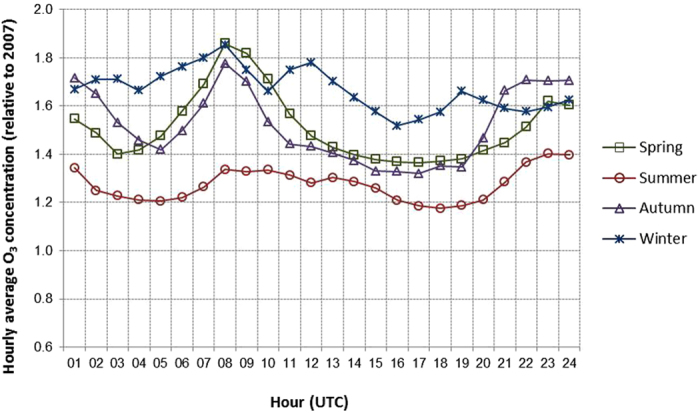
Evolution of the daily average concentration profile of O3 from 2007 to 2014 (relative to 2007 with a value = 1) in the urban background monitoring stations used in the present work.
Output of the CMAQ model at the site of the AQN stations shows an increase of O3 concentrations that ranges from 10 to 24% depending on the location of the stations (Fig. 6). For the specific location of measurement sites, the modelled O3 percentage increase is lower than that observed (30–40%). However, Fig. 6c shows that when integrated over the modelling domain, the simulated average O3 variation is 8%, with a mean value of 30% over the downtown area, in better agreement with the measured percentage change (Fig. 4).
Figure 6.
Modelled O3 annual mean concentration, (a) 2007; (b) 2014. (c) Variation of O3 annual mean concentration in 2014 with respect to 2007 and resulting statistics. Figure created by the authors using ArcGis 10 (http://www.esri.com/software/arcgis/arcgis-for-desktop).
Impact on atmospheric oxidants
We now turn to the influence of the observed O3 increase, combined with the reduction in NO2 levels, upon the concentrations of the main atmospheric oxidants (OH and NO3). Our results show that the sharp increase observed in O3 levels during the 2007–2014 period leads to a significant concentration rise in OH, which forms by photolysis of O3 and subsequent reaction with water vapour. However, additional factors may have also affected OH. For example, if NOx levels decrease, the importance of the NO2 + OH reaction also decreases. This, in turn, can increase OH since the reaction consumes less OH. Annual mean OH levels increase about 50% in the downtown area, between 4% and 70% across the different typology of the monitoring stations, and an average of 10% over the entire modelling domain (Fig. 7). Note that the modelled variation in OH is likely a lower limit since the model slightly under predicts the observed O3 trend (Fig. 6). Regarding the daily behavior of OH and NO3 radicals, daily curves are very similar for 2007 and 2014, although differences are observed as a function of stations typology (Figure S4 at Supplementary).
Figure 7.
Modelled OH annual mean concentration, (a) 2007; (b) 2014. (c) Variation of OH levels in 2014 with respect to 2007. Figure created by the authors using ArcGis 10 (http://www.esri.com/software/arcgis/arcgis-for-desktop).
Even larger changes are found in the case of the NO3 radical, the main nocturnal oxidant; Fig. 8 shows a remarkable increase of NO3 concentrations of 80% and 32% for the downtown and larger metropolitan areas, respectively. This enhanced oxidation capacity in the nocturnal atmosphere of Madrid has important air quality implications since NO3-mediated oxidation of VOCs and organic sulphur species largely influence the budgets of these species and their degradation products21. In the particular case of organic sulphur species, H2O2 is also a powerful oxidizing agent for the aqueous-phase oxidation of S(IV) into S(VI). However, H2O2 average concentration is found to be very similar in most of the modelling domain, and not to change substantially from 2007 to 2014. Thus, this species does not play a major role in the oxidative capacity changes discussed in the present work. Furthermore, NO3 efficiently reacts also with biogenic alkenes30 yielding secondary organic aerosols. In most cases, these NO3-initiated reactions lead to the formation of organic nitrates, RONO2, which represent a considerable fraction of fine particulate matter at the continental scale, and they are found at both urban and rural atmospheres31. Thus, the increase in NO3 levels in Madrid is very likely to have a profound influence on the production of SOA in the form of organic nitrates. None of the measurements included particulate matter speciation until very recently and the information is too scattered for an analysis of annual mean variation. However, airborne particulate matter concentration was simulated for both inorganic and organic aerosols at the Casa de Campo station, the only one that has a complete and consistent series over the period of interest (see Figure S5 and comments in Supplementary).
Figure 8.
Modelled NO3 annual mean concentration, (a) 2007; (b) 2014. (c) Variation of NO3 levels in 2014 with respect to 2007. Figure created by the authors using ArcGis 10 (http://www.esri.com/software/arcgis/arcgis-for-desktop).
The other important pollutant affected by the reduction in NOx levels is HNO3. The increase of OH and NO3 radicals may favour the production of HNO3 during day and night (via N2O5), respectively. However, NO2 is involved in both production channels and its decline in Madrid’s atmosphere reduces the net formation of HNO3. Our results indicate an average reduction between 6–24% in the HNO3 concentration over the metropolitan area (Fig. 9). Because of a smaller amount of HNO3, the acidification levels of the atmosphere of Madrid and the levels of ammonium nitrate in PM2.5 might have been significantly reduced in such a short period. We estimate a reduction in the total oxidized nitrogen deposition of approximately 24% from 2007 to 2014, integrated over the modelling domain.
Figure 9.
Modelled HNO3 annual mean concentration, (a) 2007; (b) 2014. (c) Variation of HNO3 levels in 2014 with respect to 2007. Figure created by the authors using ArcGis 10 (http://www.esri.com/software/arcgis/arcgis-for-desktop).
Potential influence of meteorological factors
Temperature, precipitation and mixing layer height play an important role in atmospheric chemical reactions and vertical mixing and thus on ambient pollutant concentrations. Average temperature and mixing layer height variations were analysed in order to assess their influence in the observed pollutant trends. A slight positive trend (<0.1 °C year−1) of the average annual temperature is observed, although it is not statistically significant (r2 of ~0.16). The percentage change in the average annual temperature respect to the 2007 oscillates between 0.04 and 0.09%. The annual averaged mixing layer height also shows a slight positive trend (<15 m year−1) but not statistically significant (r2 of ~0.28). The annual variation of these parameters is not sufficient to attribute the changes in atmospheric oxidant concentrations to changes in meteorological conditions. However, seasonal and monthly anomalies can contribute to explain some of the observed behaviour. During several winter months (November-December 2007 and 2012, December 2012 and 2014, and January 2012) low wind speeds and strong atmospheric stability episodes lasting 1–2 weeks were registered. These conditions triggered pollution events where NO primary emissions accumulated in the urban area, without an efficient oxidation to NO2. These periods, despite being short in time, contribute to a significant increase in monthly means of pollutant concentrations, modifying NO/NO2 ratios and in turn perturbing their general trend over these years, as seen in the case of 2011 and 2012 (Fig. S2). Hence, we conclude that the modelled rapid change in the oxidizing capacity in Madrid is not directly related to these mesoscale meteorological factors albeit stability and local winds can play a role in the variability of observed concentrations over the period of interest.
Discussion
We have shown that the observed increase in O3 levels, along with the decrease in NOx emissions over a relatively short period (from 2007 to 2014), may have led to a strong increase in OH and NO3 radical concentrations (up to 70% and 90%, respectively), thereby resulting in a rapid and dramatic enhancement in the oxidizing capacity of the urban atmosphere of Madrid. The NOx emission reduction policies and the economic crisis are abating ambient air NOx concentrations, but in turn are introducing substantial changes on atmospheric composition and chemistry that should be taken into account when designing strategies to further improve air quality in urban areas. Lower NOx emissions lead to a strong reduction in HNO3 concentrations, and all together to a denoxification of Madrid’s atmosphere and a potential decrease of PM2.5 (by decreasing ammonium nitrate formation). We suggest that this has led to a considerable reduction in the nitrogen deposition within and in the surroundings of the metropolitan area that may be relevant for ecosystems.
Our results indicate that the rapid observed trends in O3 and NOx would have led to considerable changes in OH and NO3 radical budgets, which may have significantly affected the atmospheric chemistry of the metropolitan area of Madrid via (i) increased oxidation efficiency of its urban atmosphere, (ii) reduction of its atmospheric acidity and (iii) enhanced production of secondary pollutants, including SOA. We therefore suggest that this rapidly occurring change in the oxidation efficiency of the Madrid’s atmosphere could also take place in other urban areas in Europe, where current NO2 and NOx concentration levels need to be further reduced to meet legal standards. While it is beyond the scope of this paper to estimate the associated radiative effects, NOx reductions are a common aim of air quality plans in urban agglomerations, implying that resulting changes in urban air composition could also have a substantial impact on both regional and global radiative forcing of climate.
Finally, it should be noted that, unlike other pollutants, European NO2 standards are particularly restrictive because they follow the World Health Organization guidelines. The results from this case study highlights the need to carefully design and analyze urban air quality plans that usually have the reduction of NO2 ambient concentration levels as the primary target. In particular, it is important to fully consider the effect of NOx abatement measures not only on the resulting NO2 levels but also on the potential trade-offs with other health-relevant pollutants such O3 and aerosols, along with additional environmental impacts such as N deposition to ecosystems.
Methods
Measurements
Air quality data were collected from the air quality monitoring network of Madrid. Measurements are based on normalized reference methods described in the European Directive (2008/50/CE)6. The equipment works under a rigid maintenance program being periodically tested and calibrated. The air quality monitoring and information system of the Madrid City Council is certified according to ISO 9001, ISO 14001 standards and registered with Eco-Management and Audit Scheme (EMAS). The selection of air quality monitoring stations was based on NOx and O3 data availability and consistency of the series over the 2007–2014 period, considering that the monitoring network underwent substantial modifications in 2009 and 2010. The indexes elaborated for this work were computed from over a million of hourly-validated concentration records.
Analysis of temperature and mixing layer height
Temperature and mixing layer height were obtained from the global meteorological model ECMWF (European Centre for Medium-Range Weather Forecasts). In order to extract meteorological fields for Madrid, a geographical area has been defined between 35° and 45 ° of latitude North and 2° and 5° of longitude West. Daily mixing layer height values are outputed at 12:00 UTC with a spatial resolution of 0.75° (latitude and longitude). In the case of surface temperature, four daily values are used (00:00, 06:00, 12:00 and 18:00 UTC) at a spatial resolution of 0.25°.
Mesoscale air quality model
The modelling domain covers the entire metropolitan area, i.e. Madrid City and adjacent municipalities that form an urban continuum. This domain consists of 44 × 40 = 1760 1 km2-resolution grid cells giving a total area of 1760 km2. The AQM is based on the Weather Research and Forecasting (WRF)26 (and the CMAQ)27,28 chemical-transport model. Emissions are processed with the Sparse Matrix Operator Kernel Emissions (SMOKE) modelling system29. Further details regarding model options, setup and configuration can be found in a previous work9 and references within. We used an emission projection for 2014, since the last year available for the emission inventory was 2012. The reader is referred to Borge et al.9 for details on emissions scenario computation. CMAQ is a state-of-the-art Eulerian chemistry transport model based on the one-atmosphere paradigm, i.e. solves concentration fields considering the influence of interactions at different dynamic scales and the interactions of the main pollutants and relevant chemical species both primary and secondary. It includes scalable dynamics and thermodynamics (use of fully compressible form of governing equations and a generalized coordinate system) and a modular coding structure with a wide range of representation of scale-dependent processes (e.g. clouds or horizontal diffusivity). The model is applied under a robust nesting approach to consistently describe all the relevant scales involved in urban air quality dynamics. Four nested domains with 48, 16, 4 and 1 km spatial resolution were used to perform the simulations needed in this contribution (see Borge et al. for details9). The vertical structure of the model is identical to that used for the meteorological model (no layer collapsing techniques were applied) and includes 30 layers covering the whole troposphere (up to 5000 Pa) and high resolution within the planetary boundary layer. The chemical mechanism used is the Carbon Bond 5 mechanism (CB05_AE4_AQ). CB05 is a lumped-structure mechanism that includes 156 gas phase reactions involving 51 species. A full account of species, reactions and corresponding rates can be found in a previous work32. Its implementation in CMAQ and a comparison with the previous CB-IV mechanism is described elsewhere33. The AERO4 scheme for aerosols is based on ISORROPIA thermodynamic model34. Further details regarding chemical mechanism, solvers and other physical options can be found elsewhere35.
Emissions are taken from an emission model based on the Sparse Matrix Operator Kernel Emissions (SMOKE) modelling system, described in Borge et al.29. The model selected to provide the meteorological fields required by the chemical-transport model and the emission processing system is the Weather Research and Forecasting (WRF) modelling system26. This non-hydrostatic mesoscale model constitutes a state-of-the-art atmospheric simulation system based on the Fifth-Generation Penn State/NCAR Mesoscale Model (MM5)36. A detailed description of the initialization and optimal setup of the WRF model for the Iberian Peninsula can be found in Borge et al.37. Reference about model validation for different applications can be found in previous works9,35,38,39.
Code availability
SMOKE and CMAQ modelling systems were made available by the US EPA and are supported by the Community Modeling and Analysis System (CMAS) (https://www.cmascenter.org/). The WRF model is a collaborative effort of several research institutions (NCAR, NCEP, FSL and AFWA among others) and is also freely available at the WRF model users’ page (http://www2.mmm.ucar.edu/wrf/users/).
Additional Information
How to cite this article: Saiz-Lopez, A. et al. Unexpected increase in the oxidation capacity of the urban atmosphere of Madrid, Spain. Sci. Rep. 7, 45956; doi: 10.1038/srep45956 (2017).
Publisher's note: Springer Nature remains neutral with regard to jurisdictional claims in published maps and institutional affiliations.
Supplementary Material
Acknowledgments
This study is developed under the scientific programme TECNAIRE-CM (innovative technologies for the assessment and improvement of urban air quality) funded by the Directorate General for Universities and Research of the Greater Madrid Region (S2013/MAE-2972). The authors also acknowledge the use of emission datasets and monitoring data from the Madrid City Council.
Footnotes
The authors declare no competing financial interests.
Author Contributions A.S.-L. and R.B. designed research. A.N., C.A.C., J.A.A., D.P., X.Q., B.A., F.J.G.-M., R.B., and A.S.-L. analysed data. All authors suggested new ways to examine the data, discussed the results and wrote the manuscript.
References
- Latza U., Gerdes S. & Baur X. Effects of nitrogen dioxide on human health: systematic review of experimental and epidemiological studies conducted between 2002 and 2006. International journal of hygiene and environmental health 212, 271–287, doi: 10.1016/j.ijheh.2008.06.003 (2009). [DOI] [PubMed] [Google Scholar]
- Castellanos P. & Boersma K. F. Reduction in nitrogen oxides over Europe driven by environmental policy and economic recession. Sci. Rep. 2, 265, doi: 10.1038/srep00265 (2012). [DOI] [PMC free article] [PubMed] [Google Scholar]
- Russell A. R., Valin L. C. & Cohen C. Trends in OMI NO2 observations over the United States: effect of emission control technology and the economic recession. Atmos. Chem. and Phys. 12, 12197–12209 (2012). [Google Scholar]
- Lin J. T. & McElroy M. B. Detection from space of a reduction in anthropogenic emissions of nitrogen oxides during the Chinese economic downturn. Atmos. Chem. Phys. 11, 8171–8188, doi: 10.5194/acp-11-8171-2011 (2011). [DOI] [Google Scholar]
- European Environment Agency (E. E. A.), 2015. “Air quality in Europe – 2015 report”. EEA Technical Report No 5/2015. ISBN: 978-92-9213-701-4 702-1. [Available online at: http://www.eea.europa.eu/publications/air-quality-in-europe-2015].
- Directive E. Council Directive 2008/50/EC, on ambient air quality and cleaner air for Europe. Official Journal of the European Communities (2008).
- Vrekoussis M., Richter A., Hilboll A., Burrows J. P. & Gerasopoulos E. Economic crisis detected from space: Air quality observations over Athens/Greece. Geophys. Res. Lett. 40, 458–463 (2013). [Google Scholar]
- Cuevas C. A. et al. Evolution of NO2 levels in Spain from 1996 to 2012. Scientific Reports 4, 5887, doi: 10.1038/srep05887 (2014). [DOI] [PMC free article] [PubMed] [Google Scholar]
- Borge R. et al. Emission inventories and modeling requirements for the development of air quality plans. Application to Madrid (Spain). Science of The Total Environment 466–467, 809–819 (2014). [DOI] [PubMed] [Google Scholar]
- Leighton P. A. Photochemistry of Air Pollution. Academic Press, New York, doi: 10.1126/science.135.3502.427-b (1961). [DOI] [Google Scholar]
- Saiz-Lopez A., Notario A., Albaladejo J. & McFiggans G. Seasonal Variation of NOx Loss Processes Coupled to the HNO3 Formation in a Daytime Urban Atmosphere: A Model Study. Water Air Soil Poll. 182, 197–206 (2007). [Google Scholar]
- Seinfeld J. H. & Pandis S. N. Atmospheric Chemistry and Physics: from air pollution to climate change (Wiley-Interscience, 2006). [Google Scholar]
- Finlayson-Pitts B. J. & Pitts J. N. Chemistry of the Upper and Lower Atmosphere; Theory, Experiments, and Applications (Academic Press, 2000). [Google Scholar]
- Platt U., Perner D., Schröder J., Kessler C. & Toennissen A. The diurnal variation of NO3. Journal of Geophysical Research: Oceans 86, 11965–11970, doi: 10.1029/JC086iC12p11965 (1981). [DOI] [Google Scholar]
- Heintz F., Platt U., Flentje H. & Dubois R. Long-term observation of nitrate radicals at the Tor Station, Kap Arkona (Rügen). Journal of Geophysical Research: Atmospheres 101, 22891–22910, doi: 10.1029/96jd01549 (1996). [DOI] [Google Scholar]
- Querol X. et al. 2001–2012 trends on air quality in Spain. Science of The Total Environment 490, 957–969 (2014). [DOI] [PubMed] [Google Scholar]
- Fishman J. et al. An investigation of widespread ozone damage to the soybean crop in the upper Midwest determined from ground-based and satellite measurements. Atmospheric Environment 44, 2248–2256 (2010). [Google Scholar]
- World Health Organization. Review of evidence on health aspects of air pollution - REVIHAAP Project. (http://www.euro.who.int/data/assets/pdffile/0020/182432/e96762-final.pdf). (2013, Date of Access: 16/04/2014).
- Goldstein A. H. & Galbally I. E. Known and Unexplored Organic Constituents in the Earth’s Atmosphere. Environmental science & technology 41, 1514–1521, doi: 10.1021/es072476p (2007). [DOI] [PubMed] [Google Scholar]
- Mauldin Iii R. L. et al. A new atmospherically relevant oxidant of sulphur dioxide. Nature 488, 193–196 (2012). [DOI] [PubMed] [Google Scholar]
- Brown S. S. & Stutz J. Nighttime radical observations and chemistry. Chemical Society Reviews 41, 6405–6447, doi: 10.1039/c2cs35181a (2012). [DOI] [PubMed] [Google Scholar]
- EEA. European Environment Agency (EEA), 2014. “Air quality in Europe – 2014 report”. EEA Report No. 5/2014. ISBN: 978-92-9213-489-1. [Available online at: http://www.eea.europa.eu/publications/air-quality-in-europe-2014]. (2014).
- Salvador P., Artíñano B., Viana M. M., Alastuey A. & Querol X. Multicriteria approach to interpret the variability of the levels of particulate matter and gaseous pollutants in the Madrid metropolitan area, during the 1999–2012 period. Atmospheric Environment 109, 205–216 (2015). [Google Scholar]
- Madrid’s City Council atmospheric emission inventory. http://www.mambiente.madrid.es/opencms/export/sites/default/calaire/Anexos/Resumen_emisiones_2011.pdf. (2013).
- Konovalov I. B., Beekmann M., Richter A., Burrows J. P. & Hilboll A. Multi-annual changes of NOx emissions in megacity regions: nonlinear trend analysis of satellite measurement based estimates. Atmos. Chem. Phys. 10, 8481–8498 (2010). [Google Scholar]
- Skamarock W. C. & Klemp J. B. A time-split nonhydrostatic atmospheric model for weather research and forecasting applications. Journal of Computational Physics 227, 3465–3485, doi: 10.1016/j.jcp.2007.01.037 (2008). [DOI] [Google Scholar]
- Byun D. W. & Ching J. K. S. Science Algorithms of the EPA MODELS-3 Community Multiscale Air Quality (CMAQ) Modelling System. U.S. Environmental Protection Agency, Washington, D.C., EPA/600/R-99/030 (NTIS PB2000-100561) (1999).
- Byun D. & Schere K. L. Review of the Governing Equations, Computational Algorithms, and Other Components of the Models-3 Community Multiscale Air Quality (CMAQ) Modeling System. Applied Mechanics Reviews 59, 51–77, doi: 10.1115/1.2128636 (2006). [DOI] [Google Scholar]
- Borge R., Lumbreras J. & Rodríguez E. Development of a high-resolution emission inventory for Spain using the SMOKE modelling system: A case study for the years 2000 and 2010. Environmental Modelling & Software 23, 1026–1044, doi: 10.1016/j.envsoft.2007.11.002 (2008). [DOI] [Google Scholar]
- Atkinson R. & Arey J. Gas-phase tropospheric chemistry of biogenic volatile organic compounds: a review. Atmospheric Environment 37, Supplement 2, 197–219, doi: 10.1016/S1352-2310(03)00391-1 (2003). [DOI] [Google Scholar]
- Kiendler-Scharr A. et al. Organic nitrates from night-time chemistry are ubiquitous in the European submicron aerosol. Geophysical Research Letters, n/a-n/a, doi: 10.1002/2016GL069239 (2016). [DOI] [Google Scholar]
- Yarwood G., Rao S., Yocke M. & Whitten G. Updates to the Carbon Bond Chemical Mechanism: CB05. Final Report to the US EPA, RT-0400675. Available at http://www.camx.com/publ/pdfs/CB05_Final_Report_120805.pdf. (2005).
- Sarwar G., Luecken D., Yarwood G., Whitten G. Z. & Carter W. P. L. Impact of an Updated Carbon Bond Mechanism on Predictions from the CMAQ Modeling System: Preliminary Assessment. Journal of Applied Meteorology and Climatology 47, 3–14, doi: 10.1175/2007jamc1393.1 (2008). [DOI] [Google Scholar]
- Nenes A., Pandis S. N. & Pilinis C. Continued development and testing of a new thermodynamic aerosol module for urban and regional air quality models. Atmospheric Environment 33, 1553–1560, doi: 10.1016/S1352-2310(98)00352-5 (1999). [DOI] [Google Scholar]
- Borge R., López J., Lumbreras J., Narros A. & Rodríguez E. Influence of boundary conditions on CMAQ simulations over the Iberian Peninsula. Atmospheric Environment 44, 2681–2695, doi: 10.1016/j.atmosenv.2010.04.044 (2010). [DOI] [Google Scholar]
- Grell G. A., Dudhia J. & Stauffer D. R. A description of the fifth-generation Penn State/NCAR mesoscale model. NCAR Technical Note NCAR/TN-398+STR (1994).
- Borge R., Alexandrov V., José del Vas J., Lumbreras J. & Rodríguez E. A comprehensive sensitivity analysis of the WRF model for air quality applications over the Iberian Peninsula. Atmospheric Environment 42, 8560–8574, doi: 10.1016/j.atmosenv.2008.08.032 (2008). [DOI] [Google Scholar]
- de Andrés J. M., Borge R., de la Paz D., Lumbreras J. & Rodríguez E. Implementation of a module for risk of ozone impacts assessment to vegetation in the Integrated Assessment Modelling system for the Iberian Peninsula. Evaluation for wheat and Holm oak. Environmental Pollution 165, 25–37, doi: 10.1016/j.envpol.2012.01.048 (2012). [DOI] [PubMed] [Google Scholar]
- Borge R. et al. Comparison of road traffic emission models in Madrid (Spain). Atmospheric Environment 62, 461–471, doi: 10.1016/j.atmosenv.2012.08.073 (2012). [DOI] [Google Scholar]
Associated Data
This section collects any data citations, data availability statements, or supplementary materials included in this article.



